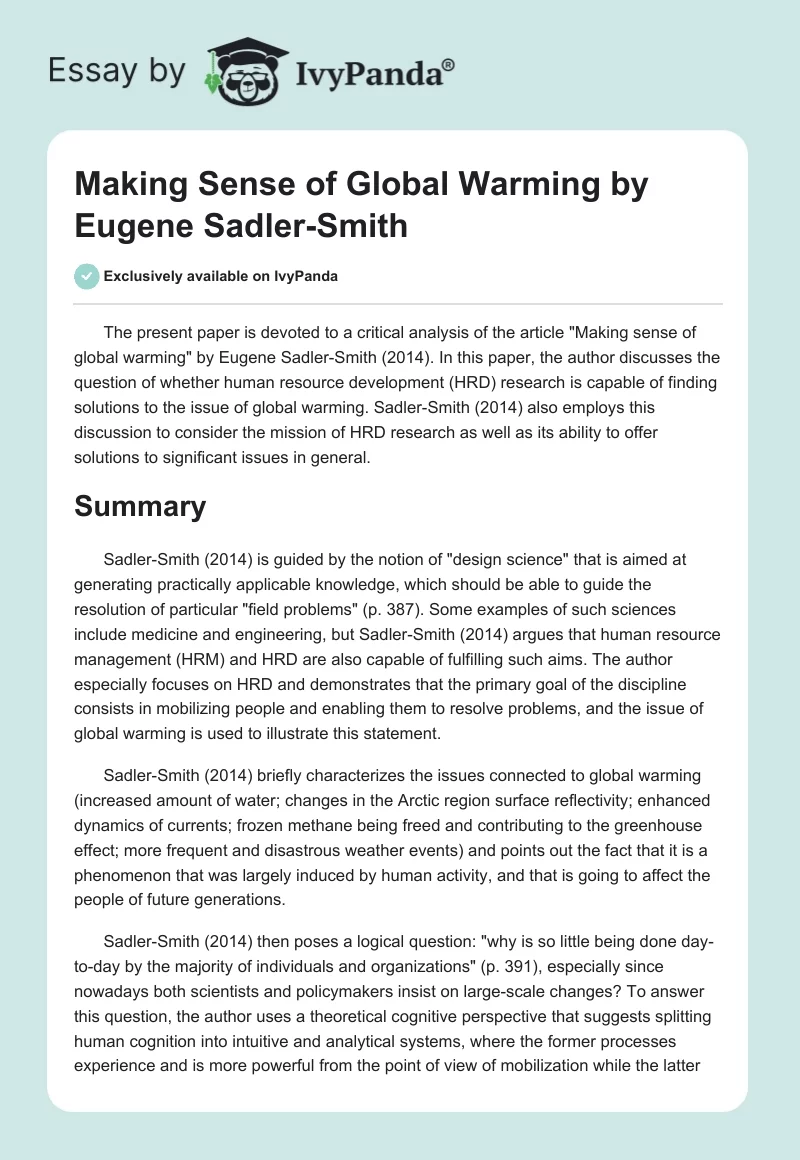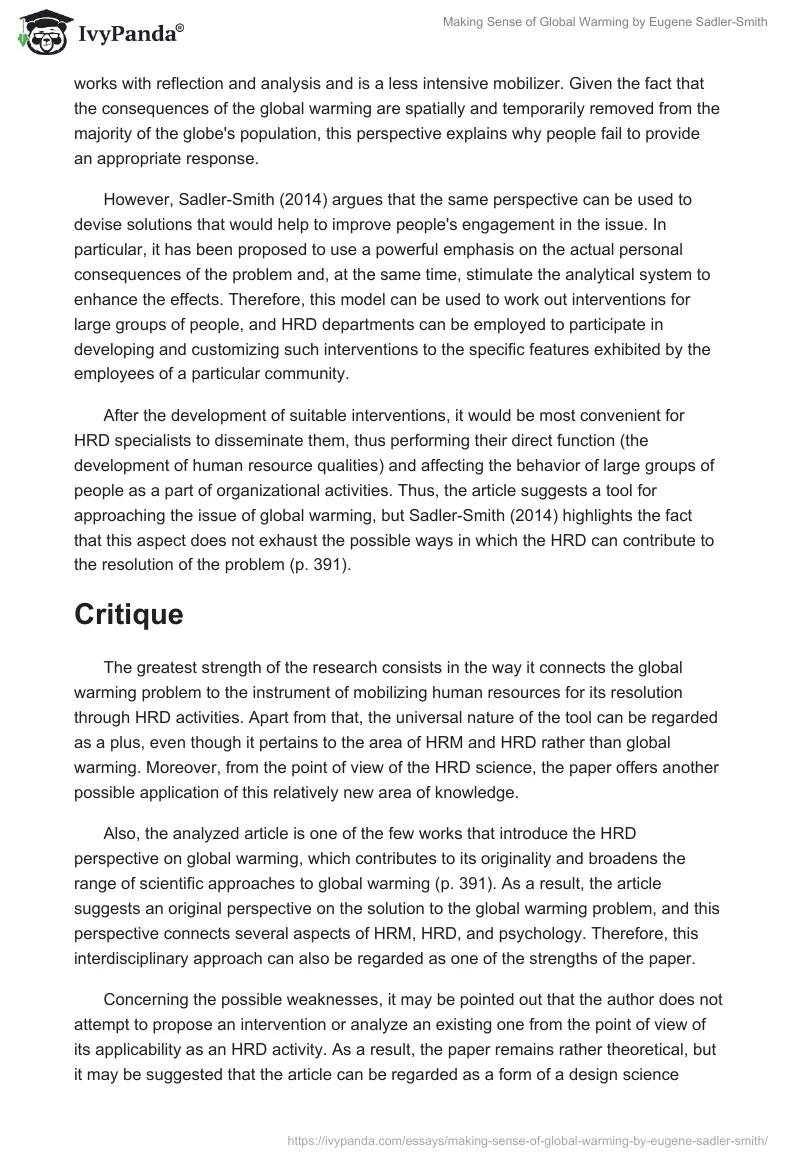The present paper is devoted to a critical analysis of the article “Making sense of global warming” by Eugene Sadler-Smith (2014). In this paper, the author discusses the question of whether human resource development (HRD) research is capable of finding solutions to the issue of global warming. Sadler-Smith (2014) also employs this discussion to consider the mission of HRD research as well as its ability to offer solutions to significant issues in general.
Summary
Sadler-Smith (2014) is guided by the notion of “design science” that is aimed at generating practically applicable knowledge, which should be able to guide the resolution of particular “field problems” (p. 387). Some examples of such sciences include medicine and engineering, but Sadler-Smith (2014) argues that human resource management (HRM) and HRD are also capable of fulfilling such aims. The author especially focuses on HRD and demonstrates that the primary goal of the discipline consists in mobilizing people and enabling them to resolve problems, and the issue of global warming is used to illustrate this statement.
Sadler-Smith (2014) briefly characterizes the issues connected to global warming (increased amount of water; changes in the Arctic region surface reflectivity; enhanced dynamics of currents; frozen methane being freed and contributing to the greenhouse effect; more frequent and disastrous weather events) and points out the fact that it is a phenomenon that was largely induced by human activity, and that is going to affect the people of future generations.
Sadler-Smith (2014) then poses a logical question: “why is so little being done day-to-day by the majority of individuals and organizations” (p. 391), especially since nowadays both scientists and policymakers insist on large-scale changes? To answer this question, the author uses a theoretical cognitive perspective that suggests splitting human cognition into intuitive and analytical systems, where the former processes experience and is more powerful from the point of view of mobilization while the latter works with reflection and analysis and is a less intensive mobilizer. Given the fact that the consequences of the global warming are spatially and temporarily removed from the majority of the globe’s population, this perspective explains why people fail to provide an appropriate response.
However, Sadler-Smith (2014) argues that the same perspective can be used to devise solutions that would help to improve people’s engagement in the issue. In particular, it has been proposed to use a powerful emphasis on the actual personal consequences of the problem and, at the same time, stimulate the analytical system to enhance the effects. Therefore, this model can be used to work out interventions for large groups of people, and HRD departments can be employed to participate in developing and customizing such interventions to the specific features exhibited by the employees of a particular community.
After the development of suitable interventions, it would be most convenient for HRD specialists to disseminate them, thus performing their direct function (the development of human resource qualities) and affecting the behavior of large groups of people as a part of organizational activities. Thus, the article suggests a tool for approaching the issue of global warming, but Sadler-Smith (2014) highlights the fact that this aspect does not exhaust the possible ways in which the HRD can contribute to the resolution of the problem (p. 391).
Critique
The greatest strength of the research consists in the way it connects the global warming problem to the instrument of mobilizing human resources for its resolution through HRD activities. Apart from that, the universal nature of the tool can be regarded as a plus, even though it pertains to the area of HRM and HRD rather than global warming. Moreover, from the point of view of the HRD science, the paper offers another possible application of this relatively new area of knowledge.
Also, the analyzed article is one of the few works that introduce the HRD perspective on global warming, which contributes to its originality and broadens the range of scientific approaches to global warming (p. 391). As a result, the article suggests an original perspective on the solution to the global warming problem, and this perspective connects several aspects of HRM, HRD, and psychology. Therefore, this interdisciplinary approach can also be regarded as one of the strengths of the paper.
Concerning the possible weaknesses, it may be pointed out that the author does not attempt to propose an intervention or analyze an existing one from the point of view of its applicability as an HRD activity. As a result, the paper remains rather theoretical, but it may be suggested that the article can be regarded as a form of a design science work: it offers a piece of knowledge that can be used in practice to resolve a particular issue. Since the interventions are more likely to have greater effectiveness when they are customized to a particular community, the mentioned weakness can be regarded as a natural limitation of a paper that suggests a general recommendation rather than a specific solution.
Conclusion
The article by Sadler-Smith (2014) demonstrates that global warming requires interdisciplinary approaches and proves the fact that HRD can play a major role in the solution of the problem, especially since humans and their behavior have been the key factors in its development.
Reference
Sadler-Smith, E. (2014). Making sense of global warming. European Journal Of Training And Development, 38(5), 387-397. Web.


